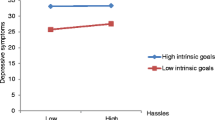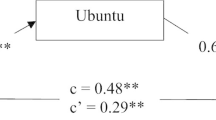Abstract
American Indian researchers and scholars have emphasized the importance of identifying variables that promote resilience and protect against the development of psychopathology in American Indian youth. The present study examined the role of self-regulation, specifically goal characteristics (i.e., goal self-efficacy, goal specificity, intrinsic vs. extrinsic motivation, and goal conflict) and dispositional optimism, as well as cultural identity and self-reported academic grades in the depressive experiences of American Indian youth from a North American plains tribe. One hundred and sixty-four participants (53 % female) completed measures of goal representations, cultural identity, dispositional optimism, academic performance, and depressive symptoms. Results supported a model in which higher goal self-efficacy, American Indian cultural identity, grade point average, and dispositional optimism each significantly predicted fewer depressive symptoms. Moreover, grade point average and goal self-efficacy had both direct and indirect (through dispositional optimism) relationships with depressive symptoms. Our findings underscore the importance of cognitive self-regulatory processes and cultural identity in the depressive experiences for these American Indian youth and may have implications for youth interventions attempting to increase resiliency and decrease risk for depressive symptoms.


Similar content being viewed by others
References
Ahrens, A. H. (1987). Theories of depression: The role of goals and the self-evaluation process. Cognitive Therapy and Research, 11, 665–680.
Auerbach, R. P., Webb, C. A., Schreck, M., McWhinnie, C. M., Ho, M., Zhu, X., et al. (2011). Examining the pathway through which intrinsic and extrinsic aspirations generate stress and subsequent depressive symptoms. Journal of Social and Clinical Psychology, 30, 856–886.
Bandura, A. (1997). Self-efficacy: The exercise of control. New York: W. H. Freeman.
Bandura, A. (2001). Social cognitive theory: An agentic perspective. Annual Review of Psychology, 52, 1–26.
Birmaher, B., Bridge, J. A., & Williamson, D. E. (2004). Psychosocial functioning in youths at high risk to develop major depressive disorder. Journal of the American Academy of Child and Adolescent Psychiatry, 43, 839–846.
Brunwasser, S. M., Gillham, J. E., & Kim, E. S. (2009). A meta-analytic review of the Penn Resiliency Program’s effect on depressive symptoms. Journal of Consulting and Clinical Psychology, 77, 1042–1054.
Byrne, B. M. (2012). Structural equation modeling with Mplus: Basic concepts, applications, and programming. New York: Routledge.
Caprara, G. V., Alessandri, G., & Barbaranelli, C. (2010a). Optimal functioning: Contribution of self-efficacy beliefs to positive orientation. Psychotherapy and Psychosomatics, 79, 328–330.
Caprara, G., Gerbino, M., Paciello, M., Di Giunta, L., & Pastorelli, C. (2010b). Counteracting depression and delinquency in late adolescence: The role of regulatory emotional and interpersonal self-efficacy beliefs. European Psychologist, 15, 34–48.
Carver, C. S., Scheier, M. F., & Segerstrom, S. C. (2010). Optimism. Clinical Psychology Review, 30, 879–889.
Cervone, D., & Scott, W. D. (1995). Self-efficacy theory of behavioral change: Foundations, conceptual issues, and therapeutic implications. In W. T. O’Donohue & L. Krasner (Eds.), Theories of behavior therapy: Exploring behavior change. Washington, DC: American Psychological Association.
Cicchetti, D., & Rogosch, F. A. (1997). The role of self-organization in the promotion of resilience in maltreated children. Development and Psychopathology, 9, 797–815.
Dearing, E., & Hamilton, L. C. (2006). Contemporary advances and classic advice for analyzing mediating and moderating variables. In K. McCartney, M. Burchinal, & K. Bub (Eds.), Best practices in developmental research methods. In A. Collins & W. Overton (Series Eds.), Monographs for the society of research in child development (Vol. 71, pp. 88–104).
Dickson, J. M., Moberly, N. J., & Kinderman, P. (2011). Journal of Abnormal Psychology, 120, 975–980.
Dweck, C. S. (2008). Can personality be changed? The role of beliefs in personality and change. Current Directions in Psychological Science, 17, 391–394.
Elliot, A. J., & Fryer, J. W. (2008). pp. In J. Y. Shah & W. L. Gardner (Eds.), Handbook of motivation science (pp. 235–250). New York, NY: Guilford Press.
Emmons, R. A. (1986). Personal strivings: An approach to personality and subjective well-being. Journal of Personality and Social Psychology, 51, 1058–1068.
Emmons, R. A. (1992). Abstract versus concrete goals: Personal striving level, physical illness, and psychological well-being. Journal of Personality and Social Psychology, 62, 292–300.
Emmons, R. A., & King, L. A. (1988). Conflict among personal strivings: Immediate and long-term implications for psychological and physical well-being. Journal of Personality and Social Psychology, 54, 1040–1048.
Evans, G. W. (2004). The environment of childhood poverty. American Psychologist, 59, 77–92.
Ferreiro, S. F., & Gloria Senra, C. (2012). Gender-related risk and protective factors for depressive symptoms and disordered eating in adolescence: A 4-year longitudinal study. Journal of Youth and Adolescence, 41, 607–622.
Fryberg, S. A., & Markus, H. (2003). On being American Indian: Current and possible selves. Self and Identity, 2, 325–344.
Geers, A. L., Wellman, J. A., Seligman, L. D., Wuyek, L. A., & Neff, L. A. (2010). Dispositional optimism, goals, and engagement in health treatment programs. Journal of Behavioral Medicine, 33, 123–134.
Gone, J. P. (2007). “We never was happy living like a Whiteman”: Mental health disparities and the postcolonial predicament in American Indian communities. American Journal of Community Psychology, 40, 290–300.
Hamill, S., Scott, W. D., Dearing, E., & Pepper, C. (2009). Affective style and depressive symptoms in youth of a North American Plains Tribe: The moderating roles of cultural identity, grade level, and behavioral inhibition. Personality and Individual Differences, 47, 110–115.
Jones, M. D., & Galliher, R. V. (2007). Ethnic identity and psychosocial functioning in Navajo adolescents. Journal of Research and Adolescence, 17(4), 683–696.
Kitayama, S., & Markus, H. R. (1999). Yin and yang of the Japanese self: The cultural psychology of personality coherence. In D. Cervone & Y. Shoda (Eds.), The coherence of personality: Social cognitive bases of personality consistency, variability, and organization (pp. 242–302). New York: Guilford.
Klein, H. J., Whitener, E. M., & Ilgen, D. R. (1990). The role of goal specificity in the goal-setting process. Motivation and Emotion, 14, 179–193.
Kline, R. B. (2005). Principles and practice of structural equation modeling (2nd ed.). New York, NY: Guilford Press.
Kovacs, M. (1985). The children’s depression inventory (CDI). Psychopharmacology Bulletin, 21, 995–998.
Kovacs, M. (1992). Manual for the children’s depression inventory. North Tonawanda, NJ: Multi-Health Systems.
Kovacs, M., Goldston, D., & Gatsonis, C. (1993). Suicidal behaviors and childhood-onset depressive disorders: A longitudinal investigation. Journal of the American Academy of Child and Adolescent Psychiatry, 32, 8–20.
LaFromboise, T. D. (1996). American Indian life skills development curriculum. Madison, WI: University of Wisconsin Press.
Lewinsohn, P. M., Rohde, P., & Seely, J. R. (1998). Major depressive disorder in older adolescents: Prevalence, risk factors, and clinical implications. Clinical Psychology Review, 18, 765–794.
Manson, S. P. (2001). Behavioral health services for American Indians: Need, use, and barriers to effective care. In M. Dixon & Y. Roubideaux (Eds.), Promises to keep: Public health policy for American Indians and Alaska Natives in the 21st century (pp. 167–192). Washington, DC: American Public Health Association.
Markstrom, C. A. (2010). Identity formation of American Indian adolescents: Local, national, and global considerations. Journal of Research on Adolescence, 21(2), 519–535.
Moran, J. R., Fleming, C. M., Somervell, P., & Manson, S. M. (1999). Measuring bicultural ethnic identity among American Indian adolescents: A factor analysis study. Journal of Adolescent Research, 14, 405–426.
Muthén, L. K., & Muthén, B.O. (1998–2010). Mplus User’s Guide (6th ed.). Los Angeles, CA: Muthén & Muthén.
Norton, I. M., & Manson, S. M. (1996). Research in American Indian and Alaska Native communities: Navigating the cultural universe of values and process. Journal of Consulting and Clinical Psychology, 64, 856–860.
Oetting, G. R., & Beauvais, F. (1990). Orthogonal cultural identification theory: The cultural identification of minority adolescents. International Journal of the Addictions, 25, 655–685.
Oetting, E. R., Swaim, R. C., & Chiarella, M. (1998). Factor structure and invariance of the orthogonal cultural identification scale among American Indian and Mexican American youth. Hispanic Journal of Behavioral Sciences, 20, 131–154.
Phinney, J. S. (1990). Ethnic identity in adolescents and adults: Review of research. Psychological Bulletin, 108, 499–514.
Phinney, J. S. (1992). The multigroup ethnic identity measure: A new scale for use with diverse groups. Journal of Adolescent Research, 7(2), 156–176.
Rieckmann, T. R., Wadsworth, M. E., & Deyhle, D. (2004). Cultural identity, explanatory style, and depression in Navajo adolescents. Cultural Diversity and Ethnic Minority Psychology, 10, 365–382.
Ryan, R. M., & Deci, E. L. (2000). Self-determination theory and the facilitation of intrinsic motivation, social development, and well-being. American Psychologist, 55(1), 68–78.
Scheier, M. F., Carver, C. S., & Bridges, M. W. (1994). Distinguishing optimism from neuroticism (and trait anxiety, self-mastery, and self-esteem): A reevaluation of the life orientation test. Journal of Personality and Social Psychology, 67, 1063–1078.
Schmid, K. L., Phelps, E., & Lerner, R. M. (2011). Constructing positive futures: Modeling the relationship between adolescents’ hopeful future expectations and intentional self regulation in predicting positive youth development. Journal of Adolescence, 34, 1127–1135.
Scott, W. D., & Cervone, D. (2009). Self-efficacy interventions: Guided mastery therapy. In W. T. O’Donohue & J. E. Fisher (Eds.), General principles and empirically supported techniques of cognitive behavior therapy (pp. 488–493). Hoboken, NJ: Wiley & Sons.
Scott, W. D., & Dearing, E. (2012). A longitudinal study of self-efficacy and depressive symptoms in youth of a North American Plains tribe. Development and Psychopathology, 24, 607–622.
Scott, W. D., Dearing, E., Reynolds, W., Lindsay, J. E., Baird, G. L., & Hamill, S. (2008). Cognitive self-regulation and depression: Examining academic self-efficacy and goal characteristics in youth of a Northern Plains Tribe. Journal of Research on Adolescence, 18, 379–394.
Scott, W. D., & Penningroth, S. L. (2009). Self-Regulation. In R. E. Ingram (Ed.), The international encyclopedia of depression (pp. 500–504). New York, NY: Springer Publishing Company.
Shahar, G., Henrich, C. C., Winokur, A., Blatt, S. J., Kuperminc, G. P., & Leadbeater, B. J. (2006). Self-criticism and depressive symptomatology interact to predict middle school academic achievement. Journal of Clinical Psychology, 62, 147–155.
Stangier, U., Ukrow, U., Schermelleh-Engel, K., Grabe, M., & Lauterbach, W. (2007). Intrapersonal conflict in goals and values of patients with unipolar depression. Psychotherapy and Psychosomatics, 76, 162–170.
Trimble, J. E. (2000). Social psychological perspectives on changing self-identification among American Indians and Alaska Natives. In R. H. Dana (Ed.), Handbook of cross-cultural and multicultural personality assessment (pp. 197–222). Mahwah, NJ: Lawrence Erlbaum.
US Census Bureau. (2009). Statistical abstract of the United States. Washington, DC: Author.
Van der Velden, P. G., Kleber, R. J., Fournier, M., Grievink, L., Drogendijk, A., & Gersons, B. P. R. (2007). The association between dispositional optimism and mental health problems among disaster victims and a comparison group: A prospective study. Journal of Affective Disorders, 102, 35–45.
Whitbeck, L. B., McMorris, B. J., Hoyt, D. R., Stubben, J. D., & LaFromboise, T. (2002). Perceived discrimination, traditional practices, and depressive symptoms among American Indians in the upper Midwest. Journal of Health and Social Behavior, 43, 400–418.
Whitesell, N. R., Mitchell, C. M., Kaufman, C. E., Spicer, P., & The Voices of Indian Teens Project Team. (2006). Developmental trajectories of personal and collective self-concept among American Indian adolescents. Child Development, 77, 1487–1503.
Yu, M., & Stiffman, A. R. (2007). Culture and environment as predictors of alcohol abuse/dependence smptoms in American Indian youths. Addictive Behaviors, 32, 2253–2259.
Author contributions
J.T. assisted in the conception of the study, participated in its design and coordination, the analysis of the data and in drafting the manuscript; W.S. assisted in the conception of the study, participated in its design and coordination, the analysis of the data, and in drafting the manuscript; T.R. participated in the analytic approach to examining the data and assisted in drafting the manuscript. S.M. participated in the analytic approach to examining the data and assisted in drafting the manuscript. All authors read and approved the final manuscript.
Author information
Authors and Affiliations
Corresponding author
Rights and permissions
About this article
Cite this article
Tyser, J., Scott, W.D., Readdy, T. et al. The Role of Goal Representations, Cultural Identity, and Dispositional Optimism in the Depressive Experiences of American Indian Youth from a Northern Plains Tribe. J Youth Adolescence 43, 329–342 (2014). https://doi.org/10.1007/s10964-013-0042-2
Received:
Accepted:
Published:
Issue Date:
DOI: https://doi.org/10.1007/s10964-013-0042-2




